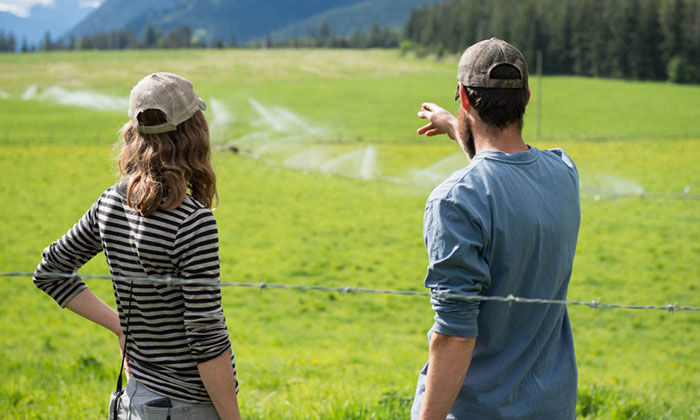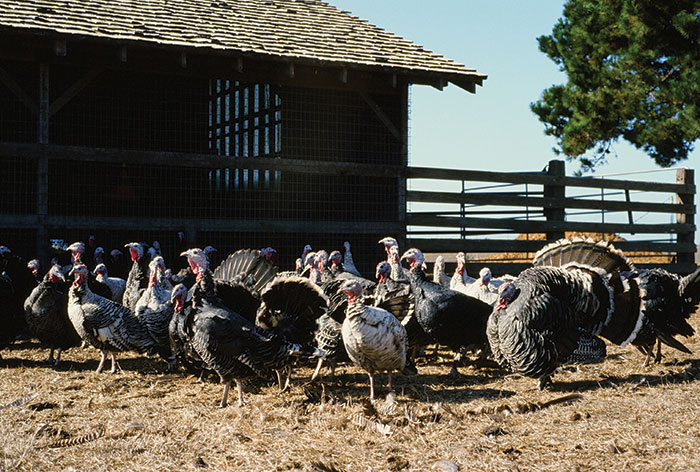Could Cows Combat Climate Change?
Small-scale ranchers say livestock, not veganism, has the potential to save the planet.
Cows and calves graze in the pastures at California’s Bolinas Ranch, the regenerative agriculture operation of vegetarian environmental-lawyer-turned-cattle-rancher Nicolette Hahn Niman.
Before they were ranchers, Tristan and Aubyn Banwell were vegans. Then, an experience homesteading led them to appreciate the importance of livestock in small-scale farming: while converting an overgrown lot into cropland, they enlisted pigs to uproot shrubs and trees, ducks to control the slugs, and chickens to recycle plant material into the soil as manure. The Banwells subsequently founded Spray Creek Ranch in 2014, where they currently raise cattle, pigs, chickens, and turkeys on 100 hectares near Lillooet, British Columbia.
Tristan sees their transition from vegans to livestock farmers as a natural result of uncovering the complexities of the food system: “I think it’s actually a really common story — there are a lot of people who follow a vegetarian or vegan diet for a period of time, and then eventually find that their concerns can be addressed by some other products. Things are a lot more complex in the food system than we realize at first blush.”
At Spray Creek, the Banwells employ the principles of regenerative agriculture — a growing movement aimed at restoring soil health and fertility through farming practices that mimic natural ecosystems. Regenerative agriculture seeks to move away from the extractive industrial model that dominates our food system, to a holistic approach that gives back to the soil as much as it takes. By employing the natural benefits of grazing animals, regenerative farmers see livestock as a solution to the climate crisis, not a cause.
Regenerative agriculture seeks to move away from the extractive industrial model that dominates our food system.
“We are inundated with reports that animal agriculture, and particularly cows, are destroying the Earth. But that is simply not true,” says Will Harris, a regenerative farmer at White Oak Pastures in Bluffton, Georgia. “What is true is that high-input industrial agriculture is rapidly destroying the land and the environment. Cows can be a part of that if they’re industrialized. But cows, sheep, and other animals in a natural grazing system can literally be the answer to climate change.”
The vast majority of meat comes from factory farms, where animals are kept in tight confinement and fed crops like corn and soy. Monocrop farms (like those growing feed) control weeds and pests through intensive tillage, plowing, and agrochemicals that destroy ecosystems’ life-giving biodiversity. And industrial agriculture isn’t restricted to the meat industry: most grains, fruits, and vegetables also come from factory farms.

Former vegans Aubyn and Tristan Banwell now raise cows, pigs, and poultry at Spray Creek Ranch outside Lillooet, BC.
“The use of chemical fertilizer and pesticides has radically changed the microbial populations in the soil, and turned the living biological medium… known as ‘soil,’ into dirt,” says Harris.
And the damage can have compounding effects. The overuse of synthetic fertilizers disrupts soil’s natural carbon cycles, meaning farms require stronger fertilizer doses to maintain yields. “It’s a downward spiral,” says Harris, “we’re increasingly dependent on chemical fertilizer.”
The same is true for herbicides like glyphosate (Roundup); as weeds become resistant, farmers apply more, which further degrades the soil. These industrial farming practices contribute to Earth’s staggering rate of soil degradation: 24 billion tonnes per year.
When grazing animals are moved from feedlots to grassland, they’re capable of restoring healthy soil, while helping to sequester carbon dioxide (CO₂) from the atmosphere. Cows and sheep are ruminants — in the same family as bison, buffalo, and wildebeest — which evolved alongside grasslands in a mutually beneficial relationship. Their digestive systems developed to break down grass, and in doing so, they help recycle nutrients back into the soil through dropping manure.
Animals in a natural grazing system can literally be the answer to climate change.
These processes rebuild soil organic matter: the fertile mixture of earth, root systems, fungal networks, and beneficial microbial populations necessary for growing nutritious food. And the world certainly needs fertile soil. Five years ago, the UN’s Food and Agriculture Organization released a report estimating we’d only have soil fit for growing food for 60 more years.
The act of grazing likewise stimulates grass to photosynthesize — the process of pulling carbon dioxide from the atmosphere and converting it into carbohydrates — according to Tom Tolputt, a regenerative farm consultant in Cornwall, UK.
“After a period of grazing,” he explains, “the plant re-concentrates its effort into reproducing biomass.”
And perennial grasslands are particularly beneficial carbon sinks: they grow deep root systems that exude carbon into the soil, feeding underground bacterial populations that help pull nutrients back into the plant. “Animals are very important because they work with perennial crops,” says Tolputt. “And perennial crops have a much greater opportunity to sequester carbon versus annual crops like soy, corn, and wheat.”
A 2016 study from Michigan State University found that if regenerative grazing practices were applied to 25% of crop and grassland in America, the carbon sequestered could fully offset the emissions of American agriculture.
“The clock is ticking,” says Bobby Gill, communications director at The Savory Institute in Boulder, Colorado. “If we want a planet to live on, we need to activate our global grasslands and regenerate them so they can be operating as efficiently as possible, pumping carbon out of the atmosphere back into the soil where it belongs.”
The Savory Institute was founded in 2009 by Alan Savory, who’s considered a pioneer of regenerative agriculture. In the 1970s, he coined the term “holistic planned grazing,” an agricultural model that mimics natural ecosystems like the Serengeti or the North American plains, where wild ruminants were moved across the land by apex predators. This built up some of the Earth’s most fertile soil — and Gill says the same can be done with domesticated livestock in a rotational system that simulates natural migration.
The institute works to establish regenerative practices on the land of a global network of farmers, ranchers, and pastoral communities, including. Will Harris’ White Oak Pastures. In the two decades since Harris began converting his 152-year-old family farm from conventional meat production to regenerative grazing, he’s increased his soil’s organic matter tenfold: from a critically low .5% to 5%. His soil now has a water-holding capacity of over 935,000 litres per hectare (about 10 centimeters of rain), and on average, sequesters about 20 tonnes of CO₂ per hectare per year.
The food industry has created a wonderful sleight-of-hand with these convenient sound bites of plant versus animal.
A study earlier this year by Quantis, a sustainability-focused research firm, found that White Oak Pastures sequesters more greenhouse gases than it emits. Their calculation analyzed all aspects of the farm — including slaughter, transport, manure, and methane emissions from the cows themselves — and found that, per kilogram of beef, White Oak sequesters 3.5 kg of CO₂, making it a net carbon sink.
That’s an emission-level 111% lower than conventional beef’s (a kilo of which results in 33 kg of CO₂ emitted). Perhaps more surprisingly, it’s also lower than that of vegan meat substitutes like Impossible Foods and Beyond Meat. In an independent life-cycle analysis, Quantis found that the Impossible Burger emits 3.5kg of CO₂ per kilogram of vegan meat, while White Oak Pastures sequesters that same amount. This is in part because genetically modified soy — the primary ingredient in the Impossible Burger — is an industrially grown monocrop, also commonly grown for animal feed. (Incidentally, the production and transport of feed accounts for 45% of animal agriculture’s carbon footprint.)
“The food industry has created a wonderful sleight-of-hand with these convenient sound bites of plant versus animal,” says the Savory Institute’s Gill. “They’re blaming feedlot animals, and then offering an ultra-processed Impossible Burger as an alternative — substituting one industrially produced food for another. The real enemy at play here is factory farming, and that’s what we need to pay attention to.”
What about feeding the world? Can regenerative agriculture feed all 7.5 billion of us? “There’s a myth that’s been fostered by big agriculture companies and meat’s opponents that we cannot feed the world without these [confinement] facilities, but that’s simply not true,” says Nicolette Hahn Niman, an environmental-lawyer-turned-cattle-rancher. “You produce a lot more meat off of land when you graze in an intentional way.”
Interestingly, Niman is a vegetarian — but still sees livestock, and particularly cows, as an “invaluable piece of the human food system.” In her 2014 book Defending Beef, Niman argues that properly managed livestock are not only a promising solution to climate change — but an efficient way to feed a growing world. Nearly one-third of our agricultural land is dedicated to growing animal feed; moving livestock to pasture would free it up for edible crops. Plus, nearly 50% of the land in North America is considered rangeland that can’t be used for crop cultivation; ruminants can make use of the shrubs, trees, and grasses that grow there and convert them into high-quality protein for humans — all while improving the soil that they feed from.

At Niman’s Bolinas Ranch, turkeys are an integral part of the regenerative agriculture system.
“You always have an oversimplification of an issue — people don’t have the time to delve deeply into it,” says Niman. “Going from ‘factory farmed meat is bad’ to ‘the solution is no meat’ is kind of a natural tendency.”
Shifting our purchasing dollars from conventional meat to regeneratively farmed meat from small farmers, Niman believes, will have a far greater effect on the market than quitting beef altogether. Spray Creek’s Tristan Banwell agrees. Their customers’ support, he notes, is the reason they can improve their farm management practices. When consumers purchase industrially farmed commodities, their dollars have to work their way through a much more complex supply chain before they can influence farming methods.
Shifting purchasing dollars from conventional meat to regeneratively farmed meat will have a greater effect on the market than quitting beef altogether.
“When you look at the reality of the industry, what do you think the Tyson [Foods] of the world are going to do? They’re going to continue slaughtering beef and chickens by the hundreds of millions, and at the same time, they’ll start producing plant-based protein sources because it’s a new market base that’s growing, and they’re going to capitalize on that,” says Banwell.
That said, Banwell doesn’t believe small-scale farms are inherently better than large-scale ones, so long as a farm’s practices are beneficial to the Earth: “I would say that the most important thing consumers can do is have their eyes open to the supply chain of their dietary choices.”
Print Issue: Winter/Spring 2020
Print Title: Could Cows Combat Climate Change?
